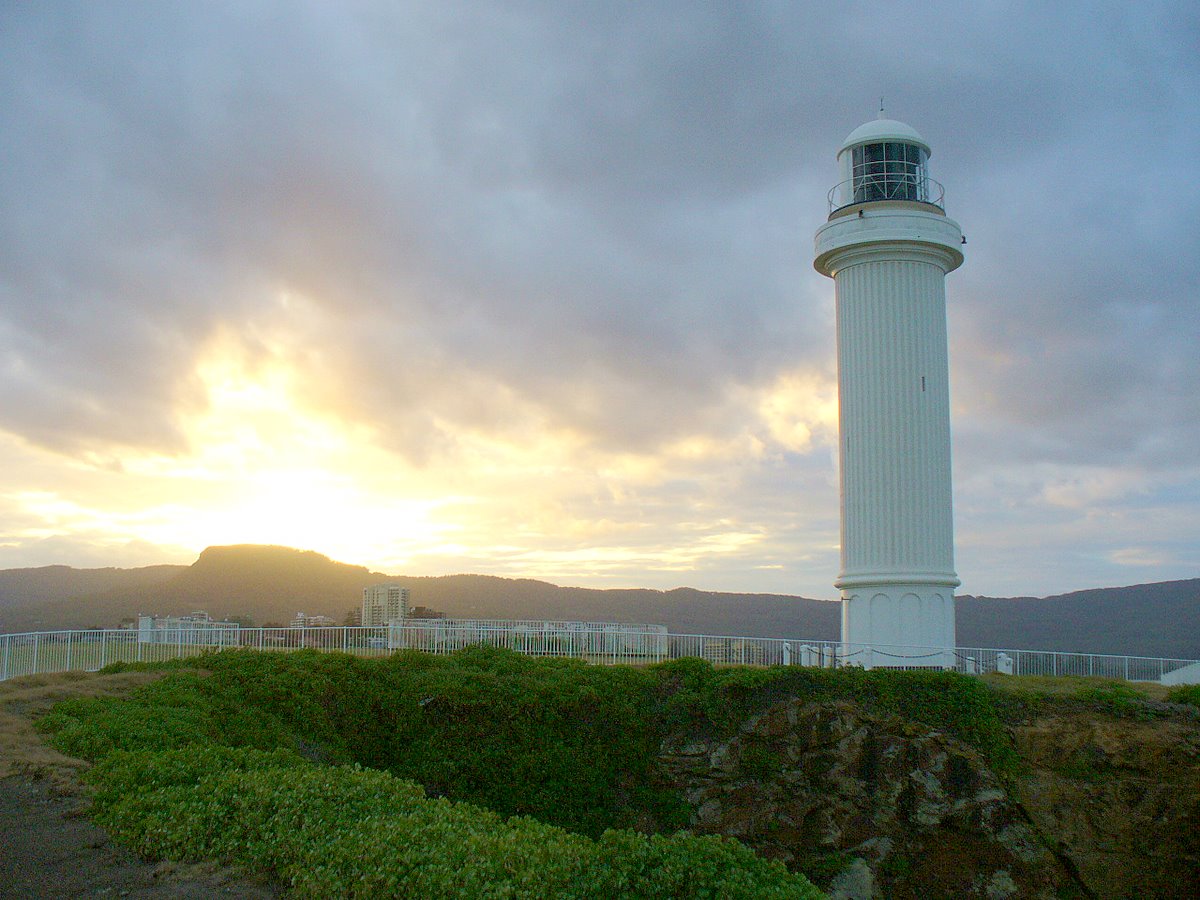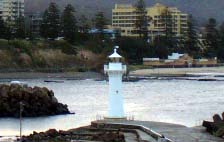- Wollongong Lighthouses
Infobox_lighthouse|name=Wollongong Head Lighthouse
location=Flagstaff Point, Wollongong, Australia
caption=
coordinates = Latitude 34° 25' S
Longitude 150°55' E
yearlit=1936
yeardeactivated=
automated=Since construction
intensity=White 70 000 cd, Red: 17 000 cd
elevation=40 metres
range=19 nautical miles (30 km)
foundation=
construction=Reinforced concrete
shape=Cylindrical
marking=White
height= 25.3 metres
lens=
characteristic=White occulting 6s, Red light towards shallow waters
admiralty=K2614
NGA=6416
ARLHS=AUS-173Wollongong with a population of nearly 200,000 is the third largest city in theIllawarra region of New South Wales (NSW), south ofSydney inAustralia . [cite web | url = http://www.wollongong.nsw.gov.au/DiscoverWollongong/72.asp | title = Wollongong City—Fast Facts | accessdate = 2007-05-24 | publisher = Wollongong City Council] It is the only place in the east of Australia to have twolighthouses that are located within close proximity of each other. The Wollongong Head Lighthouse is in current operation while its older twin, the Wollongong Breakwater Lighthouse is no longer in use after a restoration exercise in 2002 and has since became a heritage icon of the city.Wollongong Head Lighthouse
Built by the Department of Shipping and Transport in 1936 to guide maritime traffic into the Port Kembla Harbour located in the south.
Port Kembla is a major steelmaking, minerals, and more recently a grain handling harbour. It was not only the first new lighthouse in New South Wales since 1903 but also the first to install fully automatic flashing lights.cite web | last = Macdonald | first = Malcolm S |url = http://www.lighthouse.net.au/lights/NSW/Wollongong/Wollongong%20Head.htm | title = The Wollongong Head Lighthouse | accessdate = 2007-05-24 | publisher = Lighthouses of Australia Inc ] The tower is constructed of reinforced concrete to withstand the strong winds and splashing waves where it stands at the south of Flagstaff Point overlooking the Wollongong Harbour. The light is coloured white and red. White with a 4.5 second duration is visible through 100 degrees, while red is visible through 80 degrees. The latter indicates the presence of shallow water. Three 68 pounder cannons (now defunct) were installed near its base in 1879 to repel any possible attacks by the Russian navy. It finally became the sole functioning lighthouse in Wollongong Harbour when the old Wollongong Lighthouse situated only a few hundred metres away on the Belmore Basin to the north was discontinued in 1974.Due to its vantage point, it is a popular picnic-cum-scenic spot by locals, visitors and campus students from the nearby
University of Wollongong .Wollongong Breakwater Lighthouse
Infobox_lighthouse|name=Wollongong Breakwater Lighthouse
location=Belmore Basin, Wollongong, Australia
caption=
coordinates = Latitude 34° 25' S
Longitude 150°55' E
yearlit=1872
yeardeactivated=1974
automated=No
intensity=1000 cd
elevation=17.1 metres
range=10 nautical miles (18 km)
foundation=Ferro-concrete
construction=Wrought iron
height= 12.8 metres
lens=
characteristic=Group White & Red 3 in 20 Seconds
ARLHS=AUS-172The Wollongong Breakwater Lighthouse or known affectionally as "Old Wollongong Lighthouse" by the locals was built in 1871 after an earlier request made by the Wollongong Borough Council in 1866 to help mariners safely nagvigate the port of Wollongong in the early days of the coal industry in the Illawarra region. It is situated in the Belmore Basin on the southern breakwater, within walking distance to its newer twin, the Wollongong Head Lighthouse.cite web | last = Macdonald | first = Malcolm S | url = http://www.lighthouse.net.au/liGhTS/NSW/Wollongong/Wollongong%20Harbour.htm | title = The Wollongong Breakwater Lighthouse | accessdate = 2007-05-24 | publisher = Lighthouses of Australia Inc ]Designed by Edward Moriarty, the Engineer-in-Chief of Harbours and Rivers Department, the tower is constructed of wrought iron on a ferro-concrete base to survive any gale force weather in the area. It is one of the two towers in New South Wales made from wrought iron plates—another identical one was built at
Ulladulla Breakwater which later moved to Warden Head. [cite web | last = Macdonald | first = Malcolm S |url = http://www.lighthouse.net.au/liGhTS/NSW/Warden%20Head/Warden%20Head.htm | title = The Warden Head Lighthouse | accessdate = 2007-05-24 | publisher = Lighthouses of Australia Inc ] Its construction was delayed by heavy seas which the tower did survive through. Until the lighthouse came into service, a temporary red light was fixed in a box at the end of the pier. Its lantern was installed in July 1871 but its light was not exhibited regularly until January 1872.Neglect and restoration
Due to poor maintenance of the wrought iron plates in later years, its support fixtures and foundation had deteriorated so much that the lighthouse was considered unsafe and slated for demolition in the 1970s. However, the Wollongong community called for its retention and local organisations subsequently contributed to its restoration then and again in 2002. The old lighthouse has become an icon of Wollongong for its part played in its history and is often depicted on its tourist brochures and even appears as an emblem on the pocket of a local high school uniform. [cite web | url = http://www.parliament.nsw.gov.au/prod/PARLMENT/hansArt.nsf/V3Key/LA20020313040 | title = Parliamentary Secretary's Address—Wollongong Breakwater Lighthouse | accessdate = 2007-05-24 | publisher = Parliament of New South Wales ]
The new Wollongong Head Lighthouse was constructed on Flagstaff Point to the south of the Breakwater in 1937 and took over as the major light in the harbour in 1974. Though decommissioned now, it is still fully functional and its lights are only relit to mark special maritime occasion nowadays.
ee also
*
Lighthouses and lightvessels in Australia
*Mount Keira
*Kiama References
External links
* [http://www.seasidelights.com.au/au/nsw/wollongonghbr.asp?fState=NSW Picture gallery of Wollongong Harbour]
* [http://www.wollongong.nsw.gov.au/ Wollongong City Council]
Wikimedia Foundation. 2010.
